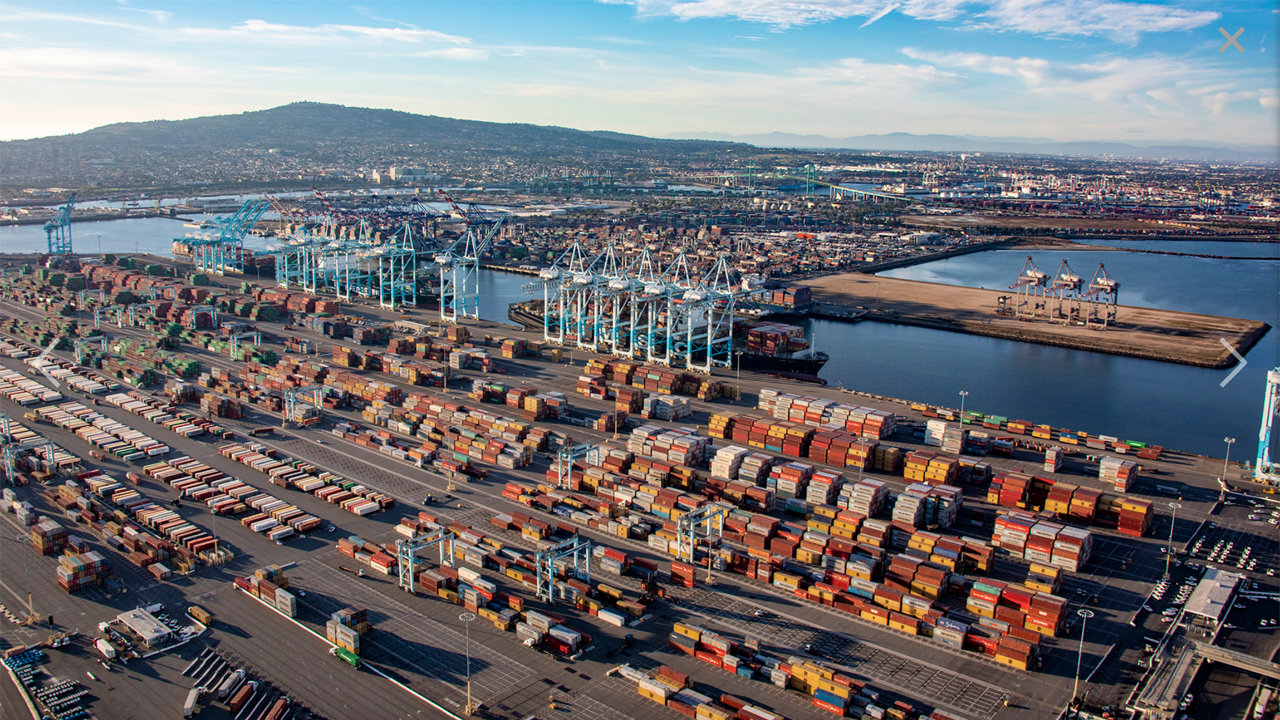
Intermodal Briefs: Port of LA, ITS Logistics, Port of Long Beach (UPDATED July 14)
Written by Marybeth Luczak, Executive Editor
The Port of Los Angeles moved 833,035 TEUs (in June, calling it the “best performance” since last July and just 5% less than last year’s record. (Photograph Courtesy of Port of Los Angeles)
The Port of Los Angeles, Calf., reports that June volume is its “strongest in a year.” Also, ITS Logistics forecasts that the labor strike at the ports of Vancouver and Prince Rupert will not only negatively impact Canada, but also will have a “severely negative impact” on the U.S. supply chain due to reconsigned freight; and the Port of Long Beach reports a slow June as industry volume stalls.
Port of Los Angeles
The Port of Los Angeles moved 833,035 TEUs (twenty-foot equivalent units) in June 2023, calling it the “best performance” since last July and just 5% less than last year’s record.
Loaded imports in June reached 435,307 TEUs, down 2% compared with the same month in 2022, while loaded exports came in at 108,050 TEUs, a 15% increase from 2022. Empty containers landed at 289,679 TEUs, a 14% year-over-year decline.
The Port handled 4,137,379 TEUs during the first six months of this year, a 24% fall-off from the prior-year period.
“Cargo volume has increased a remarkable 70% since February with four months of consecutive gains,” Port of Los Angeles Executive Director Gene Seroka said. “Although we will likely see cargo ease in July, I’m optimistic that the second half of 2023 will show improved performance compared to the first six months.”
Gene Seroka said at that time: “The tentative agreement between the International Longshore and Warehouse Union and the Pacific Maritime Association brings the stability and confidence that customers have been seeking. We’re grateful to Acting Secretary of Labor Julie Su, ILWU International President Willie Adams and PMA President James McKenna for their leadership and resolve. We look forward to collaborating with our partners in a renewed effort to bring back cargo and demonstrate why Los Angeles is the first choice for Trans-Pacific trade.”
Seroka on July 12 talked with Julie Su, who addressed her role in the recent tentative agreement and the U.S. Department of Labor’s initiatives to create jobs and empower American workers. See video below.
ITS Logistics
ITS Logistics on July 12 issued the July ITS Logistics US Port/Rail Ramp Freight Index, forecasting port container and dray operations for the Pacific, Atlantic and Gulf regions. The 3PL (third-party logistics) firm based in Reno, Nev., said the index reveals “severe conditions in the Pacific port and both East and West inland rail ramp regions due to the West Coast port labor strikes occurring in Canada.” Additionally, ITS Logistics forecasted that reconsigned freight at the Ports of Vancouver and Prince Rupert will impact the U.S. supply chain in the coming months.
“Most of the IPI freight that enters through these ports are destined to major U.S. rail hubs, including Chicago and Memphis,” said Paul Brashier, Vice President of Drayage and Intermodal at ITS Logistics, which offers drayage and intermodal services in 22 coastal ports and 30 inland rail ramps. “There is a high probability that a large portion of this freight will be reconsigned to U.S. West Coast ports if the vessels call on those ports prior to or after calling Vancouver or Prince Rupert.”

According to ITS Logistics, the Canadian ports handle nearly $225 billion in cargo annually and include items from such industries as apparel, home goods and electronics that are transported by rail. Additionally, according to port authority data, approximately 15% of consumer trade that moves through the Port of Vancouver is heading to or coming from the U.S., the 3PL firm said. It was estimated by the Canadian Manufacturers & Exporters industry group, that the movement of $500 million worth of goods is being disrupted every day the strike continues.
“Shippers should immediately put contingency plans in place to reroute freight into the U.S. and alter the mode of freight to domestic truckload in anticipation of rail congestion that will occur when the strike is resolved,” Brashier said. “Western U.S. ports will be affected due to Canadian volumes being reconsigned to the U.S. in addition to the July kickoff of retail peak season. Furthermore, the East and Gulf ports will see a spike in volume as retail peak freight starts to arrive, and since most of the freight from the U.S. East and West region rail ramp services is routed IPI to U.S. rail ramps, business there will be impacted as well. While container dwell in Western Canada increases, freight will overwhelm rail lines and ramps when it finally starts to transfer from the ocean terminals to the ramps.”
Ultimately, the rerouting of containers will add days to the delivery of products, according to ITS Logistics. “With the negotiations currently still stalled and the Canadian Parliament out of session, it is best that shippers attempt to stay ahead of this current supply chain disruption,” the 3PL firm said. “Port operations should remain stable in both the East and Gulf, but depending on the duration of the strike it could take one to three months for operations to return to normal in the West region, particularly western Canada.”
Port of Long Beach
Dockworkers and terminal operators at POLB moved 597,076 TEUs last month as “retailers continued to clear warehouses,” a 28.5% decline from June 2022 as, which was the Port’s busiest June on record. Imports were down 34% to 274,325 TEUs, while exports declined 18% to 94,508 TEUs. Empty containers moving through the Port decreased 25% to 228,243 TEUs.

According to POLB, economists report that consumer spending exceeded expectations during the first half of 2023 and may flatten out through the rest of the year.
The Port has moved 3,732,676 TEUs during the first half of 2023, down 25.5% from the same period last year.
“We are hopeful to obtain a greater percentile of market share,” POLB CEO Mario Cordero. “We remain confident that our reliability, efficiency and unparalleled service will attract additional trade and economic activity to our Port.”
“We continue to work with our industry partners to grow cargo volume and raise the bar on sustainable operations,” said Long Beach Harbor Commission President Sharon L. Weissman. “Our highly skilled workforce, infrastructure projects and environmental programs continue to make us the Port of Choice.”



